Note: This article was originally published as the MASS Research Review cover story for October 2022 and is a review of two recent papers by Anderson et al and Dinyer et al. If you want more content like this, subscribe to MASS.
Key Points
- Researchers split untrained women into two groups. Both groups performed leg extensions, seated shoulder presses, leg curls, and lat pulldowns for eight weeks. One group performed three sets to failure at 30% of 1RM (low-load group), and the other performed three sets to failure at 80% of 1RM (high-load group).
- The researchers assessed 1RM strength and body composition pre-, mid-, and post-study. Effort-based rating of perceived exertion (RPE) was assessed after each set and each session (sRPE). The affective response was assessed via the feeling scale after each session, as was the intention to complete the same exercise within the next week or month.
- Both groups tended to improve strength but not body composition, and there were no group differences for either measure. Further, there were no group differences for either RPE measure or the affective response at any time point. Additionally, feeling scale ratings were positively related to intention to train.
- All measures were unaffected by the load. Importantly, since lifters similarly enjoyed high- and low-load training, this might mean that lifters would not have an issue adhering to low-load failure training over the long-term. However, the findings from this study were not in lockstep with the literature. Overall, it seems that higher loads are preferable for strength, but hypertrophy occurs mostly independent of loading.
Five years ago, an often-cited meta-analysis from Schoenfeld et al (3) found that strength gains were augmented with high- (>60% of one-repetition maximum (1RM)) versus low- (≤60% of 1RM) load training, but muscle growth was similar between training loads. Since then, more data (4, 5) seem to confirm those findings, suggesting that lifters can choose their preferred loading paradigm (high or low loads) and maximize hypertrophy. However, lifters must consider how other factors, such as fatigue, may influence long-term adherence with low loads. Ribeiro et al. (6) found that trained men reported high session rating of perceived exertion (RPE) scores and greater ratings of “displeasure” after low-load (25-30RM) than after high-load (8-12RM) training to failure. This study prompted me to write an article titled, “Most People Find Low-Load Training to Failure Miserable.” In this article, I questioned the utility of using low loads as a sole method of long-term training, since lifters seem to enjoy it less, which may lead to decreased adherence. However, in that article’s “Next Steps,” I called for a longitudinal study to assess acute perceptual responses to see if enjoyment increases over time with low-load training. This article reviews two papers from Anderson et al (1) and Dinyer et al (2), which were part of the same study that attempted to tackle my previous proposal.
The reviewed study (1, 2) split 23 untrained women into high- (n = 12, 80% of 1RM) and low- (n = 11, 30% of 1RM) load training groups for eight weeks. Both groups performed 2-3 sets of machine-based exercises (leg extensions, seated shoulder presses, leg curls, and lat pulldowns) to failure twice per week. The researchers assessed body composition and 1RM strength on each exercise before and after the training program. Effort-based RPE was assessed after each set, and sRPE was assessed immediately after each session. Feeling scale ratings (-5 – very bad to +5 very good) and intention to exercise within the next week and next month (0% – no intention to 100% – strong intention) were assessed immediately, 15 minutes, and 60 minutes after each training session. Findings showed no significant differences between groups for strength gains, body composition changes, set RPE, sRPE, feeling scale ratings, or intention to exercise at any time point. Set RPE and sRPE scores tended to increase over time across both groups. Feeling scale ratings were positively related to intention to exercise at various points throughout the study (i.e., more pleasure related to greater intention to exercise again). These findings suggest that untrained lifters can gain strength to a similar degree with both high- and low-load training. Further, these individuals had similar perceptual and affective responses to training, suggesting that long-term training adherence may not be compromised with low-load training. However, we should consider that some individuals may prefer one type of training, and that some exercises may be more tolerable with long-term low-load failure training. Moreover, there is a large body of literature comparing high and low-load training in recent years; thus, this article is also a good opportunity to thoroughly examine the topic as a whole. Therefore, this article will:
- Thoroughly review the existing literature on high- and low-load training for strength and hypertrophy outcomes.
- Determine if the presently reviewed study’s findings are in agreement with the previous literature.
- Examine the research related to the perceptual and affective response to different loading paradigms and determine how these findings may influence long-term adherence.
- Provide practical examples of implementing both high- and low-load training into a program.
Purpose and Hypotheses
Purpose
As an overarching note, this review covers two different published papers (1, 2) that came from data collected during a single study. The researchers published the strength and body composition data in one paper (2) and the perceptual and affective responses in another (1). Therefore, going forward in this article, I will refer to both papers together as “the study” or “the presently reviewed study.”
The presently reviewed study compared long-term strength and body composition outcomes between high load (80% of 1RM) and low load (30% of 1RM) in untrained women. It also compared the perceptual and affective responses and intention to exercise between the training protocols.
Hypotheses
The researchers hypothesized the following:
- Strength gains would not be significantly different between groups.
- Body composition would improve to a similar degree in both groups.
- There would be no significant differences between groups for perceptual or affective responses.
- There would be a positive relationship between affective responses and intention to exercise.
Subjects and Methods
Subjects
23 untrained women between the ages of 18-27 completed the study. Additional subject details are presented in Table 1.

Study Protocol
This study was a parallel-groups design in which the researchers split 23 untrained women into high-load and low-load training groups for 12 weeks. Subjects completed 2-3 sets to failure twice per week during weeks 2-4 and 6-11, while weeks 1, 5, and 12 served as pre-, mid-, and post-study testing. Subjects trained four machine-based exercises (leg extension, seated shoulder press, leg curl, and lat pulldown) during each session. The high-load group used 80% of 1RM, while the low-load group used 30% of 1RM, with the load in each group being adjusted in weeks 6-11 based on the mid-study 1RM testing.
Outcome Measures
Longitudinal outcome measures included 1RM strength, bone- and fat-free mass, and body fat percentage. The researchers also compared volume load and time under tension. Further, the researchers assessed set RPE, sRPE, feeling scale ratings (affective response), and intention to perform the same training session within the next week or the next month. Further description and the time points when each outcome measure was assessed can be seen in Table 2.
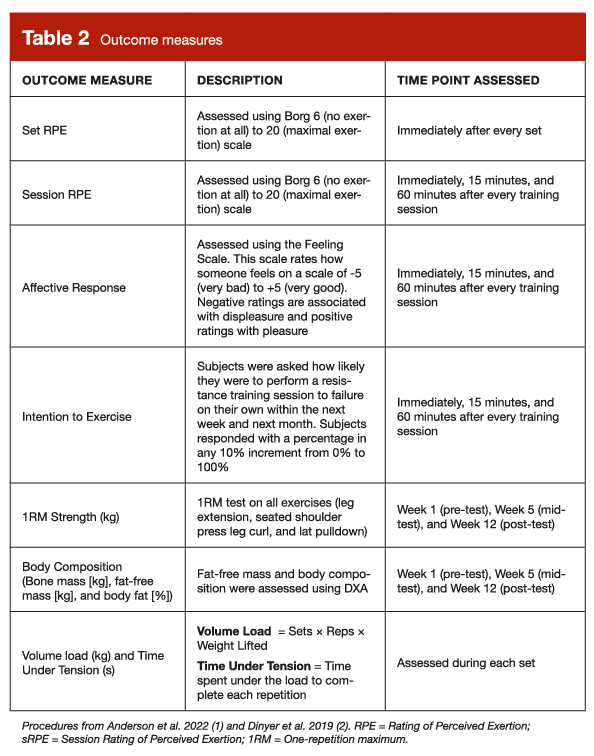
Findings
The only significant differences between groups were for volume load and time under tension. There were no significant group differences for strength gains, body composition changes, set RPE or sRPE, the affective response, or intention to exercise.
Volume, Time Under Tension, Body Composition, and Strength
The low-load group performed significantly more volume and had a greater time under tension when the researchers averaged all training sessions together (p < 0.05). In addition, strength increased significantly from pre- to mid-study and from mid- to post-study in both groups (p < 0.05), but with no significant differences between groups. Neither group significantly improved either metric of body composition (p > 0.05). However, subjects in the low-load group tended to increase bone- and fat-free mass (+1.1 kg) more than subjects in the high-load group (+0.1 kg) The findings for 1RM strength can be seen in Figure 1.
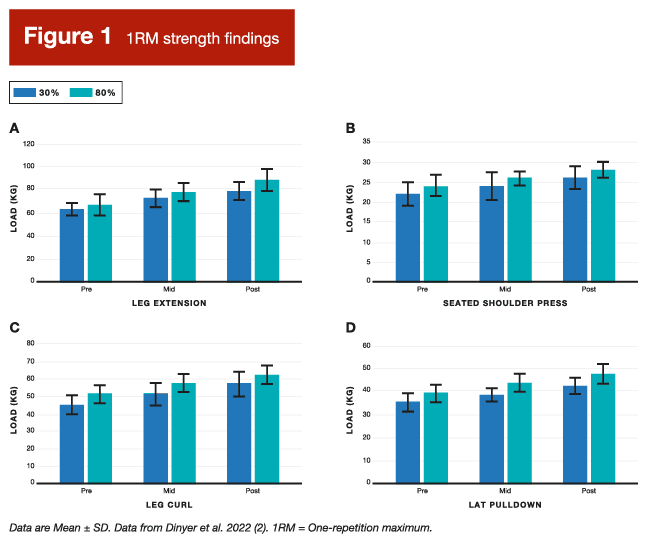
Set and Session RPE
There were no significant group differences for set RPE or sRPE. However, both RPE metrics tended to increase over time. For example, when both groups were combined, set RPEs were significantly greater during sessions 1 and 2 of weeks 4 and 8 compared to the corresponding sessions in week 1 (Table 3).
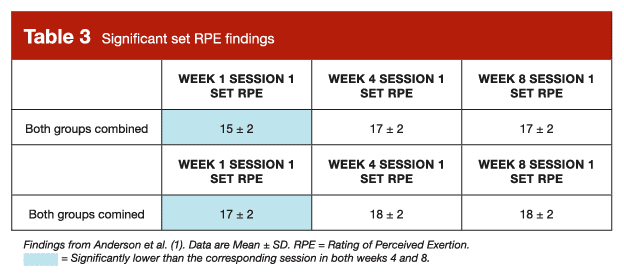
Similar to set RPE, there were also no between-group differences for sRPE, but when both groups were combined and both sessions per week were averaged, sRPE did tend to increase over time. The significant differences are in Table 4.

Affective Response
There were no significant group differences for scores on the feeling scale. However, feeling scale scores tended to be lower (less pleasurable) immediately following training than at 15 and 60 minutes post-training (Table 5).
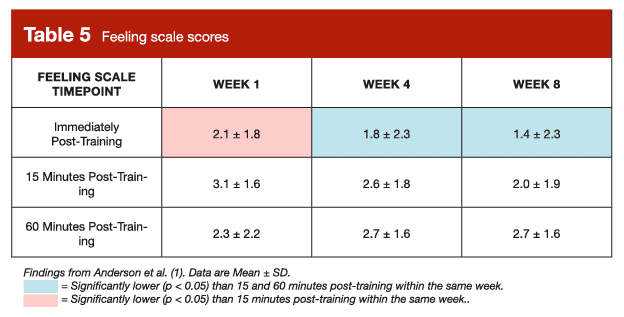
Intention to Exercise
There were no significant group differences for intention to exercise at any time point. Further, when researchers combined all subjects and averaged the responses at all time points throughout the study, subjects had an intention of 81 ± 4% and 68 ± 5% to participate in resistance training to failure in the next month and week, respectively.
Feeling scale ratings were also positively related to intention to exercise when both groups were combined at various points throughout the study (i.e., more pleasure related to greater intention to exercise again). Specifically, feeling scale scores immediately post-training in week 1 were significantly related to intent to exercise within the next month (r = 0.416, p = 0.049) and feeling scale scores 15 minutes post-training during week 4 were significantly related to intent to exercise within the next week (r = 0.497, p = 0.016) and next month (r = 0.485, p = 0.019). Finally, feeling scale scores at all time points (immediately, 15 minutes, and 60 minutes post-training) were significantly related to the intention to exercise within the next week and next month. The relationships between feeling scale scores and intention to exercise in week eight can be seen in Figure 2AB.
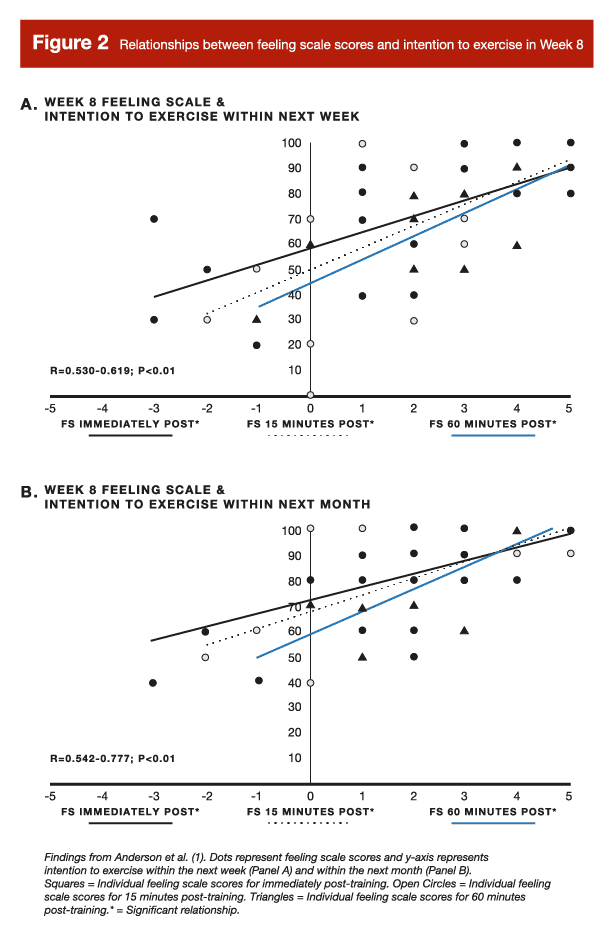
Interpretation
The previous section presented findings from two papers, Anderson et al (1) and Dinyer et al (2), which reported different outcomes from the same study. Overall, Anderson et al (1) found that untrained women reported low-load, high rep training to cause similar fatigue to high-load, moderate rep training. Further, the researchers reported that the women had a similar intent to train within the next week or month, regardless of which protocol they performed. Additionally, Dinyer et al found that strength gains and body composition changes were not significantly different between high- and low-load training. Together these findings suggest that lifters can use high or low loads for strength and potentially hypertrophy based upon preference. Further, similar sRPE and affective responses indicate that adherence to both loading zones might be similar over time. Previously, Ribeiro et al (6 – MASS Review) found that men reported higher sRPE following low-load versus high-load training; thus, the lack of group differences in this study for the perceptual and affective responses are intriguing.
Aside from the presently reviewed study, there is a relatively large body of literature comparing low- versus high-load training over the past decade, especially within the past 5-6 years. So, before getting back into both facets (performance and perceptual/affective) of the presently reviewed study, let’s take a deep dive into the totality of the high versus low-load literature. Therefore, this interpretation is split into four parts:
- I will thoroughly review how muscle hypertrophy, strength, and endurance are affected by high and low load training, including how moderating factors (sex, proximity to failure, and upper or lower body) influence the responses.
- I will review the present study’s performance findings to determine how they fit with the total body of literature.
- I’ll review the previous data on the perceptual and affective response to high- and low-load training, followed by a discussion of how the reviewed study fits with the literature.
- I’ll provide practical examples of how to incorporate high- and low-load training into your training.
It’s going to be a long Interpretation, so let’s get started.
Main Findings to Date on Strength and Hypertrophy
In the last six years, there have been five meta-analyses and a systematic review evaluating high- versus low-load training. Specifically, four of the meta-analyses examined both strength and hypertrophy outcomes (3, 4, 7, 8), one meta-analysis examined only hypertrophy, including fiber type-specific outcomes (9), while the systematic review discussed both strength and hypertrophy (5). Additionally, three (10, 11, 12) narrative reviews have covered high versus low-load training within the last five years. Before continuing, I would like to provide a working definition of high- versus low-load training; however, that’s difficult as meta-analyses used different criteria to categorize low- and high-load training. Further, some looked at training load as a continuum from 30-90% of 1RM (5), while others categorized training load as low, moderate, or high (4, 8). Therefore, even though the categorization can be much more specific, for simplicity, I’ll generally refer to high- and low-load training as training at >60% of 1RM and ≤60% of 1RM (3) unless otherwise stated. However, no matter the categorization, the consensus in this literature is quite clear: muscle hypertrophy can be maximized independently of training load, while higher loads are needed to maximize strength gains. Table 6 summarizes all six meta-analyses/systematic reviews and distinguishes how each paper categorized high-, low-, and in some cases, moderate-load training.
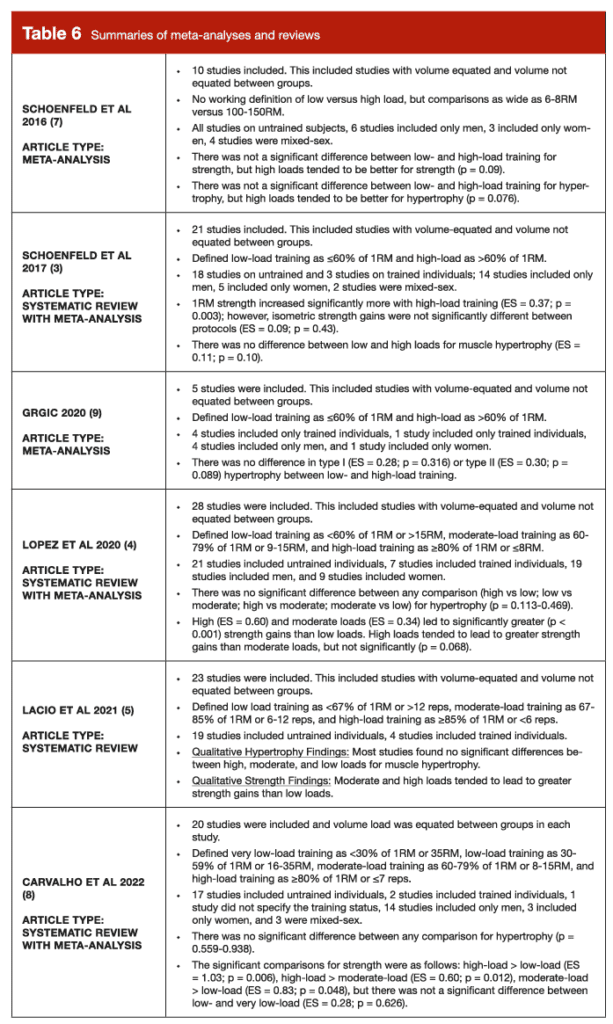
The overarching theme of the meta-analyses is that strength gains are greater with moderate- and high-load training, and hypertrophy does not appear to be significantly affected by training load. Although it’s well-known that higher loads generally lead to greater strength outcomes, it’s worth noting that the first meta-analysis on the topic (7) did not quite find significance (p = 0.09) for strength. However, that meta-analysis included only 10 studies, and all were on untrained individuals. Future meta-analyses that analyzed strength had more total studies and included both trained and untrained subjects. Therefore, it seems that the lack of significant difference (although close) for high loads to lead to greater strength gains is due to the literature being underdeveloped at the time of the first meta-analysis. In other words, a meta-analysis is only as useful as the studies it includes, and when the first one was conducted there wasn’t nearly as much data to analyze.
On balance, the meta-analyses reveal that hypertrophy seems to be unaffected by training load. I agree with that position, and it’s the opinion I primarily espouse. However, there’s enough ambiguity in the literature that I think the hypertrophy findings warrant a closer look. For example, the Grgic 2020 (9) meta-analysis found a small effect size (0.30) and p-value that was close to significance (0.089), favoring high-load training for hypertrophy of type II muscle fibers. However, Grgic’s model only included five studies (13, 14, 15, 16, 17), and only one of them (17) found a significant difference (p = 0.039) between groups for type II fiber hypertrophy. Further, although Lopez et al (4) reported no significant difference between high, moderate, and low loads for hypertrophy the authors did state the following, “the results of the consistency model indicate that moderate-load (84.5%) and high-load resistance training (75.8%) are the best load for muscle hypertrophy in overall and high-quality subgroup analyses, respectively.” In other words, when comparing high- versus low-load (19 total comparisons) and moderate- versus low-load (7 comparisons) it seemed that high and moderate loads were, on average, more likely to lead to larger increases in muscle growth than low-load training. A forest plot from Lopez’s meta-analysis comparing high- and moderate-load training versus low-load training for hypertrophy can be seen in Figure 3.
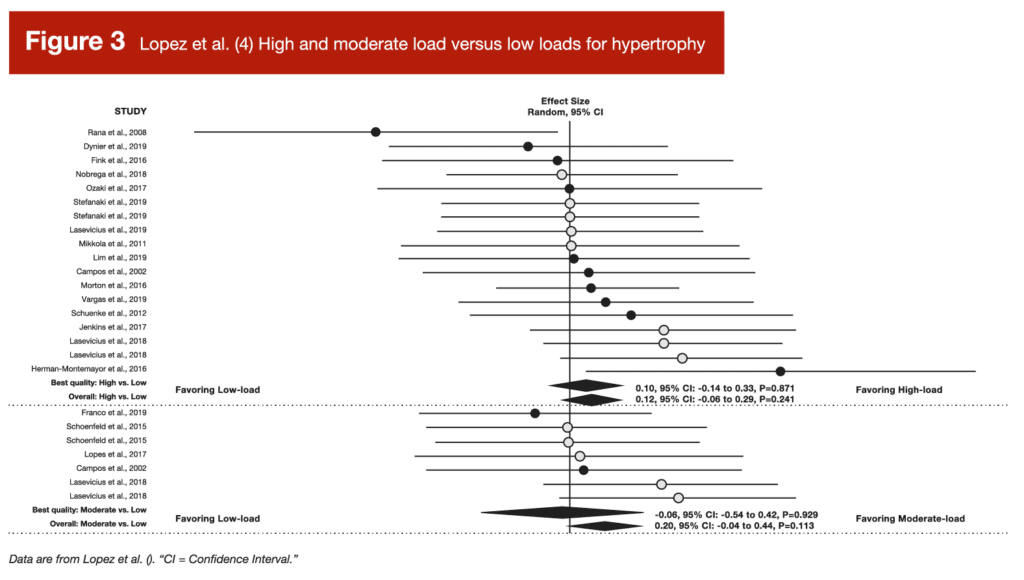
To be clear, the plot from Lopez is not convincing that high-load training leads to greater muscle growth. However, Lopez’s (4) note that higher loads tended to be better on average along with the Grgic meta (9) (albeit only five studies) suggests that the data might lean ever so slightly in the high load direction, but not to a degree which we can be confident.
In reality, there’s evidence on both sides for hypertrophy. Specifically, Schuenke et al (17) found a 25.6% and 23.4% greater increase in type I and type IIa fiber cross-sectional area, respectively, among untrained women training with 6-10RM loads than those training with 25-30RM loads. However, Franco et al (18 – MASS Review) found that untrained women gained more fat-free leg mass with 25-30 reps per set (+4.6%) than with 8-10 reps per set (+1.5%). Lastly, Stefanski et al (19 – MASS Review) found a similar increase in biceps muscle thickness among untrained women completing sets with either 80% or 30% of 1RM training for six weeks. Moreover, narrative reviews from Grgic and Schoenfeld (10) and Fisher et al (12) suggest that load does not seem to affect muscle hypertrophy, especially when volume is equated between training protocols. Finally, the Carvalho meta-analysis (8), only included volume-equated studies and showed only high p values for all of its hypertrophy comparisons (p values = 0.559 – 0.938). Therefore, even though the Lopez et al (4) meta-analysis suggests the possibility that high-load training may provide additional hypertrophic benefits, I think the most appropriate interpretation is that, on the group level, muscle growth is maximized independently of training load.
Moderating Factors
A few of the meta-analyses (4, 8) examined if factors such as training sex, training status, training upper or lower body training, and proximity to failure moderated the findings. For example, Lopez et al (4) reported that untrained individuals tended to experience more hypertrophy (p = 0.033) than trained individuals with low-load training compared to high-load training. Further, Lopez found that men tended to gain more strength than women with high-load training, but women tended to gain more strength than men with moderate-load training. In their sub-analyses, Carvalho et al found that when training not to failure, strength gains (p = 0.049) and hypertrophy (p = 0.002) were greater with high-load than with moderate-load training. In other words, when training with high loads, it seems to be preferable to train shy of failure. Notably, the Carvalho meta-analysis only included one study (20) which directly compared failure versus non-failure training; thus, Carvalho did not meta-analyze if training to failure was necessary with low loads.
Low Load Training To Failure
Despite the Carvalho meta-analysis (8) not comparing failure versus non-failure training, a few studies provide insight into the necessity of failure training with low loads to maximize hypertrophy. If you’re familiar with my content on training to failure, you may be rolling your eyes at this point and thinking, “here comes Zourdos again telling us to train 149 reps shy of failure.” If that’s you, then you can breathe a sigh of relief as I’m not here to do that this time.
There are four studies providing insight into low-load non-failure training, and they include Lasevicius et al 2022 (20 – MASS Review), Terada et al 2022 (21 – MASS Review), Ikezoe et al 2020 (22), and Kapsis et al 2022 (23 – MASS Review). Lasevicius used a within-subjects design (one leg performed each condition) and had subjects perform leg extensions not to failure or to failure at 30% of 1RM for eight weeks. The researchers reported that quadriceps cross-sectional area increased by +7.7%% in the failure condition but only by 2.6% in the non-failure condition. Terada et al (21) compared pec and triceps hypertrophy over eight weeks in untrained men bench pressing at 80% of 1RM (8 reps per set), training to failure at 40% of 1RM, or benching to a 20% velocity loss threshold at 40% of 1RM. The difference between groups wasn’t significant, but the 80% (+4.4mm; +14.5%) and 40% to failure (+4.9mm; +16.8%) groups tended to increase triceps muscle thickness more than the 40% not to failure group (+2.4mm; +8.1%). Therefore, based upon the findings of Lasevicius et al and Terada et al there seems to be an added benefit to low-load training when it’s performed to failure.
The Ikezoe et al (22) and Kapsis et al (23) studies did not compare low-load non-failure training to low-load failure training; rather, they compared low- and high-load non-failure training. Ikezoe et al (22) found no significant differences in quadriceps muscle thickness in healthy men after leg extension training of either 12 (sets) × 8 (reps) at 30% of 1RM versus 3 × 8 at 80% of 1RM for eight weeks. While Ikezoe did not report significant group differences, it should be noted that the low-load group performed nine more sets than the high-load group. Of course, it cannot be known if hypertrophy would have been the same if sets were equated. However, it’s possible that if training far from failure with low loads then additional volume is needed for muscle growth to be similar to high-load training. Lastly, Kapsis et al (23) had both women and men perform circuit training for 12 weeks. Each session consisted of four rounds of five exercises. Each round consisted of one set performed for 30 seconds at either 30% or 70% of 1RM. The researchers reported that increases in lean body mass were not significantly different between groups (30%: +1.11 kg; 70%: +1.25kg). Overall, the current body of evidence may lean toward performing low-load training to failure, or at least closer to failure, to maximize hypertrophic benefits. However, it’s premature to make definitive conclusions on the necessity of failure training or how close to failure one needs to train with low loads. The lack of ability to draw conclusions is partly because the majority of non-failure low load studies have had subjects train really far (>7 RIR) from failure; thus, we cannot know if failure training would be necessary compared to a more moderate number of RIR (i.e., 2-5 RIR).
Muscular Endurance
There isn’t a ton of data comparing high and low loads for muscular endurance; however, a new study from Fliss et al (24) was published just two days after the commencement of this article. Therefore, to be comprehensive, I wanted to briefly touch on the Fliss study. Fliss et al had untrained women perform unilateral dumbbell biceps preacher curl training and unilateral leg extensions for 10 weeks. This study was a within-subjects design, so the women performed training with one arm and one leg at a load corresponding to 80% of 1RM (6-12 reps per set) while the other side of the body performed sets with a load corresponding to 30% of 1RM (20-30 reps). The researchers assessed both absolute and relative muscular endurance. Relative muscular endurance tests the number of reps performed with a percentage of 1RM that corresponds to that specific day’s max. For example, if someone wants to test reps performed with 60% of 1RM and on that specific day their squat max is 100kg, then they would use 60kg to test muscular endurance. However, if their squat max is 105kg a week later, they would need to use 63kg to test their relative muscular endurance. To test absolute muscular endurance, this individual would always use their starting load, which was 60kg. Fliss had the women perform relative and absolute muscular endurance tests at pre- and post-study with both heavy (80% and 90% of 1RM) and light (30% and 60% of 1RM) loads. The main findings were that changes in leg extension muscular endurance tended to be specific to the training protocol. In other words, on average, the leg training at 80% of 1RM increased heavy-load absolute muscular endurance significantly more than the 30% leg; however, the 30% leg tended to improve absolute muscular endurance more with light-loads. One other note about low-load training and muscular endurance is that Terada et al (21) found that absolute muscular endurance at 40% of 1RM improved to a similar degree following bench press training to failure at 40% of 1RM and bench press training to a 20% velocity loss at 40% of 1RM. Therefore, it seems that low-load training to failure or not to failure is effective at producing improvements in muscular endurance at low loads. However, similar to low loads being inferior to high loads for strength gains, low loads also seem inadequate for increasing absolute muscular endurance at heavy loads, which, in part, demonstrates the principle of specificity. For more on the principle of specificity as it relates to muscular endurance, please see Greg’s research briefs from this month.
Where Does The Presently Reviewed Study Fit?
So now that we have thoroughly reviewed the literature on performance outcomes with high- and low-load training, does the presently reviewed study (1, 2) agree with the consensus positions? As a reminder, the reviewed study was a non-volume-equated study comparing high- (n = 12, 80% of 1RM) and low- (n = 11, 30% of 1RM) load training groups for eight weeks in untrained women. Both groups performed 2-3 sets of machine-based exercises (leg extensions, seated shoulder presses, leg curls, and lat pulldowns) to failure twice per week. Strength, on all exercises, was tested at pre-, mid-, and post-study as were fat-free mass and body-fat percentage. Both groups increased strength, but strength gains were not significantly different between groups. Further, neither group improved measures of body composition. These findings suggest that low loads are just as effective as high loads for increasing strength in untrained women and that muscle growth (although assessed indirectly) did not occur in either group.
First, the strength findings conflict with the total body of literature. Of the six meta-analyses and systematic reviews, only the very first one (7) did not find strength gains to be significantly greater with high-load training, but it was close (p = 0.09). That meta-analysis was officially published in 2016 but was published online in 2014, and the study’s search procedures ceased in 2013. In other words, it came out too early to include some data (25), which has shown strength to be increased more with high load training among untrained women. It’s possible that there were no group differences for strength gains because the subjects were untrained; thus, they could progress with low-loading.
In the presently reviewed study, there was no significant main time effect (change over time collapsed across groups) for bone- and fat-free mass, but it was close (p = 0.079). Further, fat-free mass increased by 1.1 kg in the low-load group but only by 0.1 kg in the high-load group. A 1 kg difference between groups certainly could be meaningful; however, it’s hard to read too much into it since the totality of literature suggests that muscle growth is not different between high- and low-load training.
Overall, I’m not sure that performance findings from the presently reviewed study add much to the literature, and I’m comfortable siding with the consensus of the meta-analyses that high and low loads lead to similar hypertrophy. However, high loads are needed to maximize strength gains.
Main Findings on Perceptual and Affective Responses
Despite the plethora of research examining long-term strength and hypertrophy outcomes following high- and low-load training, there are far fewer studies comparing these training paradigms for perceptual and affective responses. Therefore, before diving into the existing literature on these topics, let’s briefly explain the perceptual and affective responses and why they are necessary measures to assess.
The perceptual response to training is traditionally assessed via effort-based RPE, which I’ve written about effort-based RPE before. In brief, effort-based RPE is assessed either after every set or after the entire session (e.g., sRPE) when used in resistance training. The presently reviewed study (1) used the original Borg 6-20 scale (26); however, the Borg 0-10 scale (27) is also commonly used to assess sRPE. Both scales are anchored on the low end with a descriptor of “little to no effort” and on the high end with “maximal effort.” In general, if two protocols lead to similar hypertrophy and strength outcomes, but lifters deem that one of the protocols took less effort, then the implication is that lifters will recover more quickly from the lower effort protocol and possibly increase their long-term adherence to training.
Similar to the perceptual response, the affective response can also be assessed via a simple scale and has been suggested to have long-term adherence implications. In the presently reviewed study, the affective response was assessed via the -5 (very bad) to +5 (very good) feeling scale. Negative ratings on the scale are seen as “displeasure” while positive ratings are viewed as a “pleasurable” experience. More broadly, feeling scale responses may encompass a variety of feelings related to mood, emotion, and someone’s general psychological state (28, 29 – MASS Review). It seems intuitive that feeling scale ratings of greater pleasure (more positive) would be related to a greater intention to exercise, and they were in the presently reviewed study. However, Ekkekakis (28) indicated in a review paper that ratings of displeasure might indicate a feeling of accomplishment and pride; thus, we shouldn’t be so quick to classify negative feeling scale ratings as a sign that the lifter wouldn’t want to continue with the training program.
When comparing sRPE between high- and low-load training, some research has shown low-load training to elicit a greater sRPE (6, 30, 31), and some research has indicated high-load training to elicit a greater sRPE (32, 33, 34, 35). For example, Pritchett et al (30) found that 20 recreationally trained men reported a significantly higher sRPE following three sets on six exercises to failure at 60% than at 90% of 1RM. In agreement with Prichett (30), Shimano et al (31) found that both trained and untrained individuals reported higher sRPE following one set to failure at 60% of 1RM on the squat, bench press, and curl compared to one set to failure at both 80% and 90% of 1RM. Further, Ribeiro et al (6 – MASS Review) found that trained men reported higher sRPE, greater discomfort (on a 0-10 Likert scale), and lower feeling scale ratings (more displeasure) when following three sets to failure with a 25-30RM load on the bench press, hack squat, and lat-pulldown versus three sets to failure with an 8-12RM load. Based upon the above, I previously questioned the utility of using solely (more later on mixing high and low loads) low-load training to maximize hypertrophy because I theorized adherence and long-term enjoyment might be lower.
Other research has found that higher loads lead to a greater perceptual response than lower loads; however, those findings are likely a product of the higher load condition training closer to failure. For example, in a crossover design, Gearhart (32) had trained men and women perform 1 × 5 at 90% of 1RM in one condition and 1 × 15 at 30% of 1RM in another condition on seven different exercises. Subjects reported RPE after each rep in the 90% condition and after every three reps in the 30% condition. When all RPE scores were averaged together on each exercise, the RPE was significantly higher in the 90% condition. However, 90% of 1RM for five reps is far closer to failure or at failure (or past failure on some exercises), while 15 reps at 30% might have left some individuals with roughly 15 repetitions in reserve (RIR). Other studies have also found higher RPE following high- versus low-load training (33, 34, 35), but all have had subjects train closer to failure in the high-load condition.
Overall, load lifted may play some role in the acute perceptual and affective response, but at both high and low loads per set effort, independent of load, may be the determining factor. For instance, the previously discussed Lasevicius et al (20 – MASS Review) study had some subjects perform unilateral leg extensions to failure at 80% of 1RM on one leg and perform leg extensions shy of failure at 80% on the other leg. Another group of subjects performed unilateral leg extensions to failure and non-failure at 30% of 1RM. Importantly, in each group, the researchers had the non-failure leg perform more sets to equate volume load with the failure leg. The researchers assessed sRPE 30 minutes after each session. The subjects reported significantly higher sRPEs in both failure conditions with no difference between high-load failure and low-load failure conditions. These findings from Lasevicius can be seen in Figure 4, which is from a previous article written by Greg.
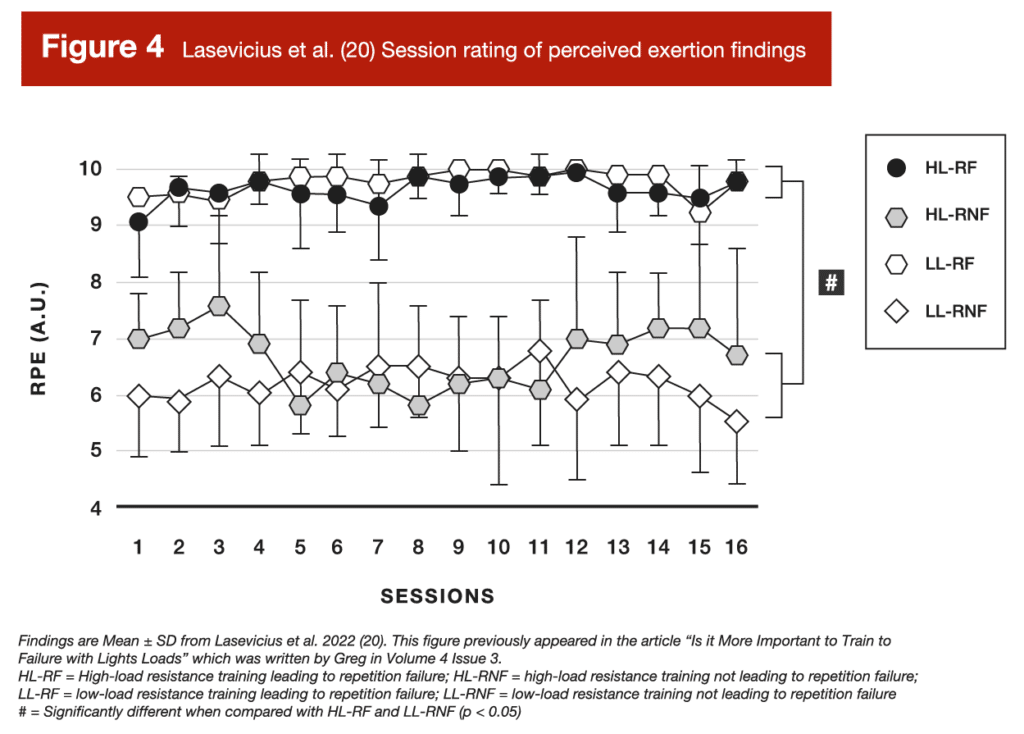
Where Does The Presently Reviewed Study Fit?
Findings from the presently reviewed study (1, 2) are, in part, at odds with the current consensus. First, the researchers found that both set and sRPE were not significantly different between high- and low-load training. This lack of difference is despite both groups training to failure and the low-load group performing significantly more volume load and spending more time under tension. As previously noted, Ribeiro et al (6) found that sRPE was significantly higher with low load than with high-load training when lifers performed both protocols to failure and sets were equated. Further, Ribeiro reported that subjects had feeling scale scores of displeasure after low-load failure training and scores of pleasure after high-load training. Yet, the presently reviewed study found similar scores of pleasure (Table 5) after both protocols.
The other findings from Dinyer et al (2) were that sRPE values tended to increase over the study while feeling scale ratings tended to decrease. Although the researchers did not statistically analyze it, Figure 4 from Lasevicius et al (20) shows that sRPE values did not seem to change, on average, from the beginning to the end of the study. Speculatively, the increase in sRPE in Dinyer could be due to accumulated fatigue since the subjects were untrained, while Lasevicius’ subjects were trained, but we cannot be sure. However, the decline in feeling scale ratings over time (Table 5) along with the increase in sRPE (Table 4), makes sense. In other words, the women tended to express lower ratings of pleasure when they perceived more effort.
Perhaps the most critical finding of the presently reviewed study is that feeling scale scores at all time points (immediately, 15 minutes, and 60 minutes post-training) were positively related to the intention to exercise within the next week and month (Figure 2AB). My previous hesitation in recommending low loads over the long term was due to a potential lack of adherence; however, the presently reviewed study suggests that my position may have been unfounded. Interestingly, previous research has not always found feeling scale scores to be predictive of intent to exercise in the future. Specifically, Focht et al (36) observed trained women to record higher (more pleasurable) feeling scale scores following training at 40% of 1RM than at 70% of 1RM. However, despite lower feeling scale scores, subjects had a greater intention to exercise following the 70% of 1RM condition in the future. Importantly, when intent to exercise is assessed, researchers ask how likely someone is to perform the same exercise session again within the next week or month. So, even though subjects did not find the moderate-load 70% of 1RM training as pleasurable as the low-load 40% training, they indicated a greater likelihood to repeat the training. One explanation is that feeling scale scores pick up on various factors related to mood, emotion, physical fatigue, and a sense of accomplishment; thus, subjects may have been more fatigued after the 70% condition. However, that fatigue did not deter them from wanting to repeat the session. Additionally, the subjects in Focht’s study were trained; thus, it’s possible they knew that higher loads were preferable for strength gains; thus, their greater desire to continue performing the 70% training was partly based upon wanting to maximize improvement.
Ultimately, the presently reviewed findings are not in lockstep with previous literature; however, there isn’t much data on the long-term affective response to high- and low-load training. Therefore, I am not yet wholly convinced that using solely low loads over the long-term is a viable strategy, especially if low loads need to be performed to failure (or at least closer to failure than when using high loads) to maximize muscle growth, which is still open for debate. Importantly, and as with most training concepts, training with high or low loads is not an all or none principle; instead, it can be intertwined into the same training program.
Practical Implementation
If one thing is clear from this article, both high- (and moderate-) and low-load training have merit. Sure, if you’re interested in maximizing your squat or bench press strength, you must train heavy at some point. However, even someone interested in top-end strength could still use low load training for hypertrophy, especially on assistance work. Further, if you’re a physique athlete or just interested in generally growing muscle, then either low or high loads should work just fine.
As noted earlier, a lifter doesn’t have to make a binary choice between low or high loads. I think we too often think training decisions are a binary choice. For example, research has debated if it’s better to prescribe load with RIR or velocity; however, as I’ve pointed out before, those concepts can be intertwined, and the specific situation might dictate which autoregulation strategy is used. Further, suppose one training strategy does tend to work better than another. In that case, we often become antagonistic toward the inferior approach, but it’s important to remember that it might work to some degree. Besides, research mostly looks at mean data, and in most studies, at least a few individuals respond better to the “inferior” protocol. In the present context, high-load training leads to better strength gains than low-load training, but in research low-load training groups still get stronger. In fact, many of the strength tests in research are 1RM strength, and low loads are not specific to 1RM testing. For example, in the Fliss study (24), absolute muscular endurance (reps performed) improved more with low-load training than with high-load training. In other words, adaptations tend to be specific to the training protocol. Besides, if someone is just generally training to gain muscle, then 1RM strength is not of great importance to the person. Therefore, just because some are using low loads does not mean they won’t gain any strength.
The specific training phase or exercise may also dictate whether high- or low-load training is used. For example, if a powerlifter is in an intensity block close to a meet, the lifter likely wouldn’t use low-load training since it’s too unspecific to their current goal. However, if a powerlifter is in a volume block six months out from a meet, they might include some low-load training to accumulate volume. Specifically, a powerlifter may utilize low loads on assistance movements like curls, triceps extensions, or rows while training in a more traditional 6-15 hypertrophy rep range on the competition lifts. Another outside-of-the-box example would be for a powerlifter to work up to a heavy squat or bench press single (e.g., 1 rep at 1 RIR) a couple of times per week and then back off to 40% of 1RM for their volume work. The bottom line is that there are many ways to intertwine the different loading schemes.
Ultimately, suppose someone is training for general purposes (e.g., hypertrophy, body composition, general health, and fitness), their training should meet the main tenets of an appropriate program. In that case, the details (i.e., high or low loads, periodization type, programming strategies) can be filled with what they enjoy and will sustain. For example, if an individual likes the exhaustive feeling of performing low loads to failure but is worried that it will become too much over time, they should include various loading schemes. For others who have a specific goal (i.e., powerlifting, physique, etc.), the programming details will need to be filled with a strategy that will best prepare the lifer for that goal; however, this often includes various loading paradigms. Besides, even if you’re a powerlifter, performing sets of 20 reps on curls is still fun.
To finish up this monster of an article are tables showing examples of how to intertwine high- and low-load training.

Table 7 demonstrates using heavy singles on the main lifts and low loads on the back-off sets. You’ll notice that the squat and bench press frequency is twice per week and sessions on the same exercise are separated by 72 hours. I chose a frequency of twice per week as opposed to three times per week and to spread out the sessions in case there’s any lingering fatigue for a couple of days from the low-load training. Of course, lifters can perform more assistance work after the main lifts and on an off day, but this table is a simple example of isolating the concept of heavy singles followed by performing volume with low-load training.
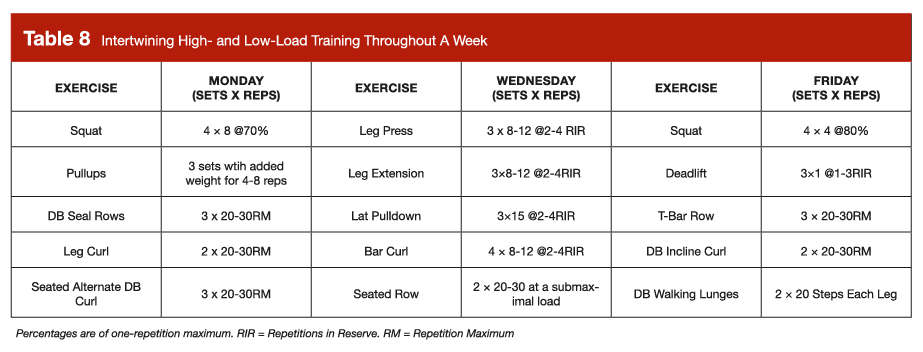
Table 8 demonstrates how to integrate high, moderate, and low loads throughout a week. This table also shows that the main lifts (squats and deadlifts in this example) are trained with moderate to high loads, and some assistance work is programmed with low loads. When intertwining multiple training strategies, some nuanced details must be manipulated to make everything work, and that is no exception here. For example, on Wednesday, I did not include squats, as there might still be some general fatigue from the low-load, high rep failure training on Monday; thus, I utilized leg press as the main lift. Further, Wednesday is largely devoid of low-load training to account for lingering fatigue from Monday. There is low load non-failure training for one exercise on Wednesday (seated row). Even though non-failure low load training may be suboptimal for muscle growth, it is still useful, and is an easy way to add some volume if fatigue lingers from Monday’s session. Friday’s heavy squats and deadlifts are placed as far as possible (96 hours) away from the low-load failure training to ensure the lifter is fresh. For example, walking lunges don’t specify that the 20 steps are to actual failure because that’s extraordinarily difficult on walking lunges. Further, low-load assistance movements have a 10 rep range spread (20-30 RM) because, in practice, it may be difficult to know your 20RM, 25RM, or 30RM load. Further, a lifter may end up getting more or fewer reps than predicted on some assistance movements since lifters typically don’t keep the movement pattern as strict on those movements (i.e., rows, curls, etc.) as they do on the main lifts. Therefore, just generally aiming for that rep range should be sufficient to perform low-load training to failure effectively. Lastly, Table 8 is just a conceptual example, and there are many ways to intertwine high- and low-load training. Additionally, someone could include many other exercises instead of those chosen.
Next Steps
The last time I covered low- versus high-load training, I called for a long-term study on high- versus low-load training that assessed the perceptual and affective response. Well, we got that study, but I’m still unfulfilled. I think the next step is replicating the presently reviewed study using trained individuals. In a dream world, I’d like to see two replications in trained individuals, one that uses a compound exercise like the squat and another that uses single-joint exercises only (e.g., biceps curls and triceps extensions).
Get more articles like this
This article was the cover story for the October 2022 issue of MASS Research Review. If you’d like to read the full, 150-page October issue (and dive into the MASS archives), you can subscribe to MASS here.
Subscribers get a new edition of MASS each month. Each edition is available on our member website as well as in a beautiful, magazine-style PDF and contains at least 5 full-length articles (like this one), 2 videos, and 8 Research Brief articles.
Subscribing is also a great way to support the work we do here on Stronger By Science.
Application and Takeaways
- Anderson et al (1) and Dinyer et al (2) found that long-term strength and body composition changes were not different between groups of untrained women performing low-load (30% of 1RM) and high-load (80% of 1RM) training to failure. Further, this study found that the perceptual and affective responses to high and low loads were not significantly different.
- The totality of literature in this area suggests that high loads are needed to maximize strength, but muscle growth can be maximized independently of load, as long as load is ≥ 30% of 1RM.
- Overall, using high or low loads does not have to be a binary choice for coaches and lifters. All loading schemes can, and probably should, be intertwined. For example, a powerlifter could use high loads on the main lifts but low loads on assistance work to accumulate volume and facilitate hypertrophy.
- For general training purposes, if someone enjoys one style of training and can adhere to that style over the long-term, I would encourage them to train as they see fit. Training for general fitness or muscle growth allows for considerable flexibility in programming; thus, programming based upon preference is perfectly fine if the programming is sustainable.
References
- Anderson OK, Voskuil CC, Byrd MT, Garver MJ, Rickard AJ, Miller WM, Bergstrom HC, McNeely TK. Affective and Perceptual Responses During an 8-Week Resistance Training to Failure Intervention at Low vs. High Loads in Untrained Women. The Journal of Strength & Conditioning Research. 2022 May 9:10-519.
- Dinyer TK, Byrd MT, Garver MJ, Rickard AJ, Miller WM, Burns S, Clasey JL, Bergstrom HC. Low-load vs. high-load resistance training to failure on one repetition maximum strength and body composition in untrained women. The Journal of Strength & Conditioning Research. 2019 Jul 1;33(7):1737-44.
- Schoenfeld BJ, Grgic J, Ogborn D, Krieger JW. Strength and hypertrophy adaptations between low-vs. high-load resistance training: a systematic review and meta-analysis. The Journal of Strength & Conditioning Research. 2017 Dec 1;31(12):3508-23.
- Lopez P, Radaelli R, Taaffe DR, Newton RU, Galvão DA, Trajano GS, Teodoro JL, Kraemer WJ, Häkkinen K, Pinto RS. Resistance training load effects on muscle hypertrophy and strength gain: Systematic review and network meta-analysis. Medicine and Science in Sports and Exercise. 2021 Jun;53(6):1206.
- Lacio M, Vieira JG, Trybulski R, Campos Y, Santana D, Filho JE, Novaes J, Vianna J, Wilk M. Effects of Resistance Training Performed with Different Loads in Untrained and Trained Male Adult Individuals on Maximal Strength and Muscle Hypertrophy: A Systematic Review. International journal of environmental research and public health. 2021 Oct 26;18(21):11237.
- Ribeiro AS, Dos Santos ED, Nunes JP, Schoenfeld BJ. Acute effects of different training loads on affective responses in resistance-trained men. International journal of sports medicine. 2019 Dec;40(13):850-5.
- Schoenfeld BJ, Wilson JM, Lowery RP, Krieger JW. Muscular adaptations in low-versus high-load resistance training: A meta-analysis. European journal of sport science. 2016 Jan 2;16(1):1-0.
- Carvalho L, Junior RM, Barreira J, Schoenfeld BJ, Orazem J, Barroso R. Muscle hypertrophy and strength gains after resistance training with different volume-matched loads: a systematic review and meta-analysis. Applied Physiology, Nutrition, and Metabolism. 2022;47(4):357-68.
- Grgic J. The effects of low-load vs. high-load resistance training on muscle fiber hypertrophy: A meta-analysis. Journal of Human Kinetics. 2020 Aug 31;74(1):51-8.
- Grgic J, Schoenfeld BJ. Are the hypertrophic adaptations to high and low-load resistance training muscle fiber type specific?. Frontiers in physiology. 2018 Apr 18;9:402.
- Schoenfeld BJ, Grgic J, Van Every DW, Plotkin DL. Loading recommendations for muscle strength, hypertrophy, and local endurance: a re-examination of the repetition continuum. Sports. 2021 Feb 22;9(2):32.
- Fisher J, Steele J, Smith D. High-and low-load resistance training: interpretation and practical application of current research findings. Sports Medicine. 2017 Mar;47(3):393-400.
- Campos GE, Luecke TJ, Wendeln HK, Toma K, Hagerman FC, Murray TF, Ragg KE, Ratamess NA, Kraemer WJ, Staron RS. Muscular adaptations in response to three different resistance-training regimens: specificity of repetition maximum training zones. European journal of applied physiology. 2002 Nov;88(1):50-60.
- Lim CH, Kim HJ, Morton RW, Harris R, Philips SM, Jeong TS, Kim CK. Resistance exercise-induced changes in muscle metabolism are load-dependent. Med Sci Sports Exerc. 2019 Oct 9;51(12):2578-85.
- Mitchell CJ, Churchward-Venne TA, West DW, Burd NA, Breen L, Baker SK, Phillips SM. Resistance exercise load does not determine training-mediated hypertrophic gains in young men. Journal of applied physiology. 2012 Jul 1;113(1):71-7.
- Morton RW, Oikawa SY, Wavell CG, Mazara N, McGlory C, Quadrilatero J, Baechler BL, Baker SK, Phillips SM. Neither load nor systemic hormones determine resistance training-mediated hypertrophy or strength gains in resistance-trained young men. Journal of applied physiology. 2016 Jul 1;121(1):129-38.
- Schuenke MD, Herman JR, Gliders RM, Hagerman FC, Hikida RS, Rana SR, Ragg KE, Staron RS. Early-phase muscular adaptations in response to slow-speed versus traditional resistance-training regimens. European journal of applied physiology. 2012 Oct;112(10):3585-95.
- de Castro Franco CM, da Silva Carneiro MA, Alves LT, de Oliveira Júnior GN, de Sousa JD, Orsatti FL. Lower-load is more effective than higher-load resistance training in increasing muscle mass in young women. The Journal of Strength & Conditioning Research. 2019 Jul 1;33:S152-8.
- Stefanaki DG, Dzulkarnain A, Gray SR. Comparing the effects of low and high load resistance exercise to failure on adaptive responses to resistance exercise in young women. Journal of sports sciences. 2019 Jun 18;37(12):1375-80.
- Lasevicius T, Schoenfeld BJ, Silva-Batista C, Barros TD, Aihara AY, Brendon H, Longo AR, Tricoli V, Peres BD, Teixeira EL. Muscle failure promotes greater muscle hypertrophy in low-load but not in high-load resistance training. Journal of strength and conditioning research. 2022 Feb 12;36(2):346-51.
- Terada K, Kikuchi N, Burt D, Voisin S, Nakazato K. Low-load resistance training to volitional failure induces muscle hypertrophy similar to volume-matched, velocity fatigue. The journal of strength & conditioning research. 2022 Jun 1;36(6):1576-81.
- Ikezoe T, Kobayashi T, Nakamura M, Ichihashi N. Effects of Low-Load, Higher-Repetition vs. High-Load, Lower-Repetition Resistance Training Not Performed to Failure on Muscle Strength, Mass, and Echo Intensity in Healthy Young Men: A Time-Course Study. The Journal of Strength & Conditioning Research. 2020 Dec 1;34(12):3439-45.
- Kapsis DP, Tsoukos A, Psarraki MP, Douda HT, Smilios I, Bogdanis GC. Changes in Body Composition and Strength after 12 Weeks of High-Intensity Functional Training with Two Different Loads in Physically Active Men and Women: A Randomized Controlled Study. Sports. 2022 Jan 4;10(1):7.
- Fliss MD, Stevenson J, Mardan-Dezfouli S, Li DC, Mitchell CJ. Higher-and lower-load resistance exercise training induce load-specific local muscle endurance changes in young women: a randomised trial. Applied Physiology, Nutrition, and Metabolism. 2022 Aug 26(ja).
- Jessee MB, Buckner SL, Mouser JG, Mattocks KT, Dankel SJ, Abe T, Bell ZW, Bentley JP, Loenneke JP. Muscle adaptations to high-load training and very low-load training with and without blood flow restriction. Frontiers in physiology. 2018 Oct 16;9:1448.
- Borg G. Perceived exertion as an indicator of somatic stress. Scand j rehabil med. 1970;2:92-8.
- Borg GA. Psychophysical bases of perceived exertion. Med sci sports exerc. 1982 Jan 1;14(5):377-81.
- Ekkekakis P. Pleasure and displeasure from the body: Perspectives from exercise. Cognition and Emotion. 2003 Jan 1;17(2):213-39.
- Emanuel A, Smukas IR, Halperin I. How one feels during resistance exercises: A repetition-by-repetition analysis across exercises and loads. International Journal of Sports Physiology and Performance. 2020 Aug 10;16(1):135-44.
- Pritchett RC, Green JM, Wickwire PJ, Kovacs MS. Acute and session RPE responses during resistance training: Bouts to failure at 60% and 90% of 1RM. South African Journal of Sports Medicine. 2009;21(1).
- Shimano T, Kraemer WJ, Spiering BA, Volek JS, Hatfield DL, Silvestre R, Vingren JL, Fragala MS, Maresh CM, Fleck SJ, Newton RU. Relationship between the number of repetitions and selected percentages of one repetition maximum in free weight exercises in trained and untrained men. The Journal of Strength & Conditioning Research. 2006 Nov 1;20(4):819-23.
- Gearhart JR RE, Goss FL, Lagally KM, Jakicic JM, Gallagher J, Gallagher KI, Robertson RJ. Ratings of perceived exertion in active muscle during high-intensity and low-intensity resistance exercise. The Journal of Strength & Conditioning Research. 2002 Feb 1;16(1):87-91.
- Day ML, McGuigan MR, Brice G, Foster C. Monitoring exercise intensity during resistance training using the session RPE scale. The Journal of Strength & Conditioning Research. 2004 May 1;18(2):353-8.
- Diniz RC, Martins-Costa HC, Machado SC, Lima FV, Chagas MH. Repetition duration influences ratings of perceived exertion. Perceptual and Motor Skills. 2014 Feb;118(1):261-73E.
- Sweet TW, Foster C, McGuigan MR, Brice G. Quantitation of resistance training using the session rating of perceived exertion method. The journal of strength & conditioning research. 2004 Nov 1;18(4):796-802.
- Focht BC, Garver MJ, Cotter JA, Devor ST, Lucas AR, Fairman CM. Affective responses to acute resistance exercise performed at self-selected and imposed loads in trained women. The Journal of Strength & Conditioning Research. 2015 Nov 1;29(11):3067-74.




